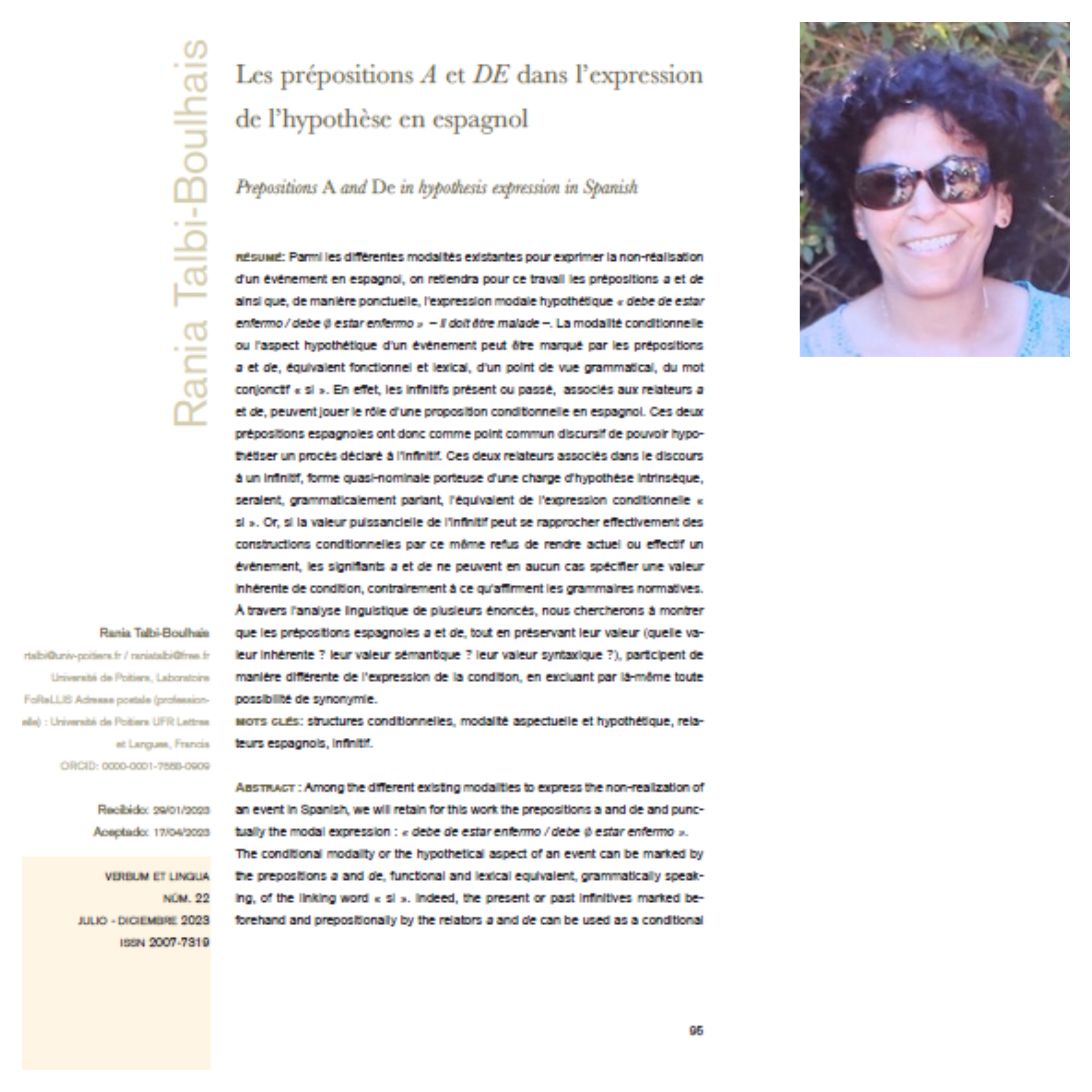Les prépositions A et DE dans l’expression de l’hypothèse en espagnol
DOI:
https://doi.org/10.32870/vel.vi22.212Parole chiave:
structures conditionnelles, modalité aspectuelle et hypothétique, relateurs espagnols, infinitifAbstract
Parmi les différentes modalités existantes pour exprimer la non-réalisation d’un événement en espagnol, on retiendra pour ce travail les prépositions a et de ainsi que, de manière ponctuelle, l’expression modale hypothétique « debe de estar enfermo / debe ? estar enfermo » – il doit être malade –. La modalité conditionnelle ou l'aspect hypothétique d'un événement peut être marqué par les prépositions a et de, équivalent fonctionnel et lexical, d’un point de vue grammatical, du mot conjonctif « si ». En effet, les infinitifs présent ou passé, relateurs a et de, peuvent jouer le rôle d’une proposition conditionnelle en espagnol. Ces deux prépositions espagnoles ont donc comme point commun discursif de pouvoir hypothétiser un procès déclaré à l’infinitif. Ces deux relateurs associés dans le discours à un infinitif, forme quasi-nominale porteuse d’une charge d’hypothèse intrinsèque, seraient, grammaticalement parlant, l’équivalent de l’expression conditionnelle « si ». Or, si la valeur puissancielle de l’infinitif peut se rapprocher effectivement des constructions conditionnelles par ce même refus de rendre actuel ou effectif un événement, les signifiants a et de ne peuvent en aucun cas spécifier une valeur inhérente de condition, contrairement à ce qu’affirment les grammaires normatives. À travers l’analyse linguistique de plusieurs énoncés, nous chercherons à montrer que les prépositions espagnoles a et de, tout en préservant leur valeur (quelle valeur inhérente ? leur valeur sémantique ? leur valeur syntaxique ?), participent de manière différente de l’expression de la condition, en excluant par là-même toute possibilité de synonymie.
Downloads
Metriche
Riferimenti bibliografici
BEDEL J.-M. (2019). Nouvelle grammaire de l'espagnol moderne. Paris: Presses Universitaires de France.
BÉNABEN M. (1993). Manuel de linguistique espagnole. Paris: Ophrys.
COSTE J., REDONDO A. (1987). Syntaxe de l'espagnol moderne. Paris: S.E.D.E.S.
ECO U. (2006). Dire presque la même chose : Expériences de traduction. Paris: Grasset & Fasquelle.
GERBOIN P., LEROY C. (1997). Grammaire d'usage de l'espagnol contemporain. Paris: Hachette-Éducation.
GUILLAUME G. (1971). Leçons de linguistique de Gustave Guillaume 1948-1949, série B, Psycho-systématique du langage. Principes, méthodes et applications I. 2, Grammaire particulière du français et grammaire générale (IV. Publiées par R. VALIN. Québec-PARIS: PUL — Klincksieck.
GUILLAUME G. (1973). Leçons de linguistique de Gustave Guillaume 1948-1949, série C. 3, Grammaire particulière du français et grammaire générale [IV]. Publiées par R. Valin. Québec-Paris: PUL -Klincksieck.
GUILLAUME G. (1974). Leçons de linguistique de Gustave Guillaume 1949-1950, série A. 4, Structure sémiologique et structure psychique de la langue française II. Publiées par R. Valin. Paris — Québec: PUL-Klincksieck.
GUILLAUME G. (1994). Langage et science du langage, Paris: A.G. Nizet- préface de Roch VALIN et R.L.WAGNER [1933-1958].
HERNANZ CARBÓ M. L. (1999). « El infinitivo » en I. Bosque y V. Demonte (eds.) Gramática descriptiva de la lengua española. Madrid: Espasa: 2197-2356.
JIMÉNEZ M. (1999). La préposition « a » en espagnol contemporain : recherche d'un représenté possible. Villeneuve d'Ascq: Presses Universitaires du Septentrion « Thèse à la carte ».
JULIÁN MARISCAL O. (2014). « "Excepto que": una locución a caballo entre la excepción y la condición » en Revista de Historia de la Lengua Española. Sevilla: Servicio de Publicaciones de la Universidad, Vol. 9, 79-97.
MARCOVECCHIO A. M., PACAGNINI A.M.J. (2019). « Prótasis condicionales con infinitivos preposicionales. Su sistematización en el aula de ELSE ». Lenguaje y Textos (50), 39-49. https://doi.org/10.4995/lyt.2019.12334.
MOLHO M. (1975). Sistemática del verbo español. Madrid: Gredos-« Biblioteca Románica Hispánica ».
PAGÈS S. (2019). Grammaire expliquée de l’espagnol. Malakoff : Armand Colin.
POTTIER B. (1962). Systématique des éléments de relation. Étude de morpho-syntaxe structurale romane. Paris: Klincksieck.
REAL ACADEMIA ESPAÑOLA (1996). Esbozo de una nueva gramática de la lengua española. Madrid: Espasa-Calpe-16° edición.
REAL ACADEMIA ESPAÑOLA (2021). Nueva gramática de la lengua española. Barcelona: Editorial Planeta-13° edición.
ROEGIEST E. (1980). Les prépositions -A- et -DE- en espagnol contemporain. Valeurs contextuelles et signification générale. Gent : RUG, Fac Lettres n°168.
SECO M. (1970). Diccionario de dudas y dificultades de la lengua española. Madrid: Aguilar.
TRUJILLO R. (1988). Introducción a la semántica española. Madrid: Arco Libros.

Pubblicato
Versioni
- 2024-08-30 (2)
- 2023-07-01 (1)












